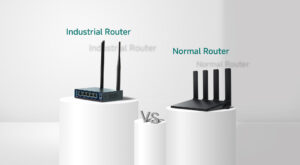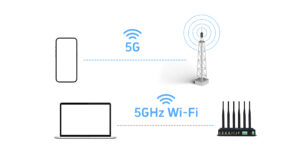Are 5G and 5 GHz the same thing? Although these two terms look very similar and are both related to internet connectivity, they refer to different aspects of wireless communication. 5G is the latest generation of cellular mobile communication technology, while 5 GHz is one of two Wi-Fi frequency bands. If this sounds confusing, don’t worry. We’ll explain in detail below.
What is 5G?
5G, the full name of the fifth generation of mobile communication technology, is a wide-area cellular network provided by operators. It is the next generation of communication standard after 4G, with significant advantages such as high speed, low latency and large connections. 5G technology is widely used in industrial fields such as smart manufacturing, remote monitoring, and automatic control. Therefore, more and more companies are beginning to deploy industrial 5G routers to achieve high-speed and stable remote connections.
Compared with traditional cellular networks, 5G has higher bandwidth and is suitable for high-definition video transmission, AI edge computing, and large-scale IoT device access. And its ultra-low latency characteristics also make industrial control systems more responsive and secure.
What is 5GHz Wi-Fi?
5GHz Wi-Fi is a wireless LAN frequency band that is part of Wi-Fi technology. Wi-Fi has two available frequency bands: 2.4 GHz and 5 GHz. 5 GHz is a newer frequency band that provides a range of excellent features. Because the channels do not overlap, the congestion level of 5 GHz is much lower than that of the 2.4 GHz band. Therefore, compared with 2.4GHz Wi-Fi, it has faster transmission speeds and less channel interference, which is suitable for high-density data transmission scenarios. For example, in industrial parks, workshops, or production control rooms, if a large-bandwidth wireless connection is required, many 산업용 라우터 will provide 5GHz Wi-Fi functions to meet the needs. However, 2.4 GHz Wi-Fi also has its advantages. It has a much larger coverage range than 5 GHz, and due to its longer wavelength, it has a stronger ability to penetrate walls.
The core difference between 5G and 5GHz
First of all, 5G is a mobile communication network that requires a SIM card to be inserted and connected to the operator’s network to use. It has a large coverage range and is suitable for long-distance and wide-area wireless communications.
5GHz Wi-Fi is based on a local wireless LAN. It transmits signals from a router or 무선 액세스 포인트. It does not require a SIM card and has a limited coverage range. It is suitable for short-range high-speed communication.
Secondly, the deployment methods of the two are also different. The 5G network is supported by operators and has a relatively high deployment cost; while 5GHz Wi-Fi can be built independently and has greater flexibility, but it also relies more on the signal quality and interference control of the on-site environment.
How to choose in industrial communications?
In industrial scenarios, 5G and 5GHz Wi-Fi each have their own advantages. The specific choice depends on the application requirements:
If you need remote monitoring, data upload, and strong device mobility, it is recommended to choose an industrial 5G router with 5G function to achieve a reliable wide-area connection.
If your application is focused on factory buildings, workshops, or control centers and requires high transmission speeds, you can choose communication devices that support 5GHz Wi-Fi, such as routers and wireless 5GHz APs, to build a high-speed, low-interference wireless local area network. For example, in smart logistics scenarios, Come-Star’s dual-band wireless AP (including the 5GHz band) deployed for AGV systems ensures that AGVs can upload real-time travel trajectories and receive dispatch instructions within workshops. Even in densely populated environments, it maintains high-speed data transmission, meeting AGVs’ requirements for low latency and high stability, and adapting to the high-dynamic operational rhythm within factories.
In summary, although the names 5G and 5GHz are similar, they are fundamentally different. One is a wide-area mobile communication network provided by operators, while the other is a local short-range high-speed wireless connection. For industrial applications, understanding the differences between them will help you make a more informed choice when selecting the appropriate industrial router or industrial 5G router, enabling you to build a stable and efficient communication system.


